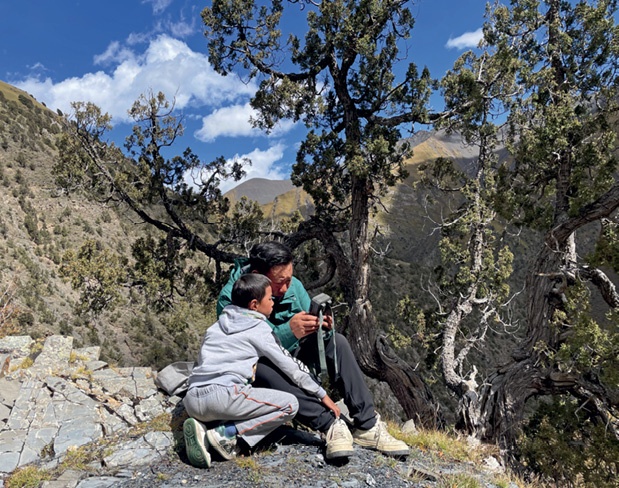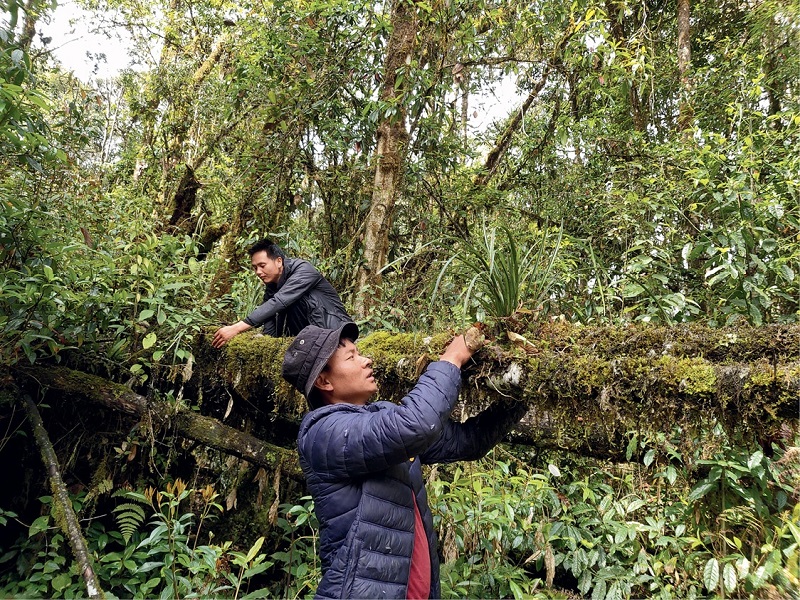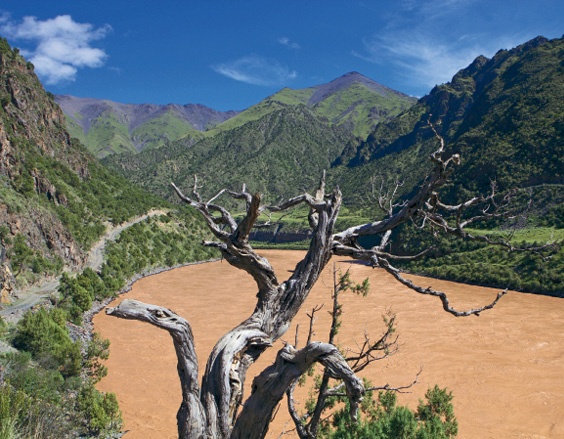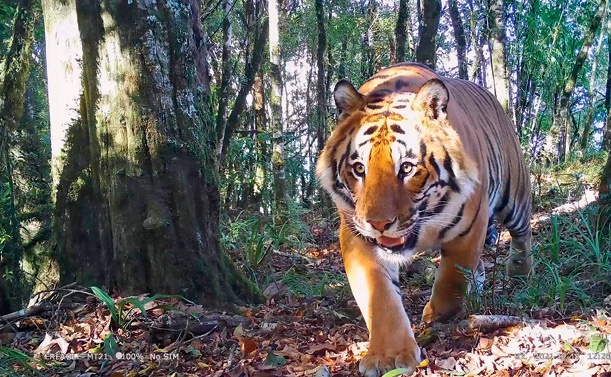
Namjagbarwa Peak can be seen in the distance. Lin Wen
As the awareness of both the government and the general public has grown regarding environmental protection, it has become a general consensus that ecosystems need to be protected by relying on local guardians with broad societal support and participation. Against this backdrop, Professor Lü Zhi and Sun Shan from the School of Life Sciences at Peking University founded the Shan Shui Conservation Center in 2007, aiming to find ways to realize the harmonious coexistence between man and nature by balancing ecological conservation with socioeconomic development.
At the center’s inception, a plan to “count snow leopards” was drawn up. Back then, the snow leopard remained one of the most elusive animals to document and observe in the wild, while at the same time, its population’s health serves as a critical indicator of the local ecosystem’s functionality and quality. Fifteen years later, the number of snow leopards across the vast Sanjiangyuan region (spanning over 300,000 square kilometers) has finally been scientifically quantified, marking a milestone in understanding and protecting this iconic species and its habitat.

Herder-monitor Zang Duo and his son from Yunta Village in Yushu Tibetan Autonomous Prefecture check their infrared camera together.
Counting Snow Leopards
Sitting in my sunlit office on the dawn of an early summer, my thoughts drift to the distant Sanjiangyuan region, where fresh greenery is likely just emerging. There, the fleeting warmth of spring and summer normally passes in a blink. In Yunta Village — a remote community far beyond Yushu Tibetan Autonomous Prefecture — nights remain cold and dry. Yet none of this dims my constant longing to revisit that region.
In 2011, I arrived in Yunta Village as a trainee at the Shan Shui Conservation Center. This villages nestled in an area along the Tongtian River in Yushu, Qinghai Province, became my home for three years.
Even today, conducting snow leopard population surveys relies heavily on infrared cameras, tools that demand long-term maintenance and management. The grueling work of traversing through the Qinghai-Tibet Plateau at altitudes exceeding 4,000 meters is beyond the endurance of most researchers or conservationists. The participation of local herders in this work has proven the most vital and practical approach to sustaining these efforts.
After living in Yunta Village for nearly a year, and with the support of Prof. Lü Zhi, I collaborated with Dr. Liu Yanlin and Dr. Xiao Lingyun to launch a community-based monitoring initiative involving local herders. Today, I can still recall the biting winds of November 2011, when 14 of the most capable young people from the surrounding villages were selected to form the first team of herder-monitors.
They documented snow leopard activity across an area exceeding 300 square kilometers, collecting data and replacing camera batteries every three months. By 2021, Yunta’s monitoring results were the first to be published. Among the 4,362 snow leopard photographs captured around the village, 35 individual snow leopards were identified.
Though limited to the scale of a single village, these findings nonetheless helped fill a critical gap in China’s research on snow leopard population dynamics. Based on the data that was collected, it was revealed that Yunta serves as a vital ecological corridor for snow leopard migration. Ensuring the openness of such corridors is essential to promoting snow leopard dispersal and genetic exchange across the Sanjiangyuan region.
The Yunta model gave us great confidence that with technological advancements, local herders are fully capable of monitoring and collecting data.
We later expanded our efforts in 2014 to collecting data from Diqing Village in Zadoi County, the starting point of the Lancang River which flows through six countries downstream. With strong backing from Tseten Dru, then magistrate of Zadoi, our snow leopard research and conservation work scaled up from a single village to a township, then county-wide efforts, and ultimately encompassed the entire Sanjiangyuan region.
These endeavors were later combined with the pilot “One Household, One Ranger” policy which appointed a member of every housold to work as an ecological guardian. This policy was launched in 2015 in Sanjiangyuan National Park, ensuring the continuity and systematic management of conservation activities. Supported by diverse stakeholders, including scientists, conservationists, volunteers, local communities, and indigenous residents, collaborative efforts have gradually mapped out the activity of snow leopards across increasingly vast areas.

In Gelin Village in Medog County, Xizang, thousands of orchids have been reintroduced back into the wild to revive local ecosystems through the Orchid Rewilding Initiative.
A Whimsical Adventure
In 2020, the immense task of organizing the data sent back to Beijing began. Painstaking efforts were required to distinguish the similarities and differences between each snow leopard’s unique coat pattern. Over 100,000 photographs had to be manually compared — a Herculean effort sustained by my colleagues and volunteers’ persistence.
Dr. Xiao established a standardized analytical framework and methodologies for organizing all the data. Through the collaborative work of Dr. Jia Ding, Dr. Li Xueyang, Wei Chunyue, Liang Shujie, Liang Miaomiao, and countless volunteers, an individual snow leopard database grew from 1 to 10 and now exceeds 400 entries. Each leopard is documented by their distinct coat markings and unique “life story,” and a cute name is given to each of them.
Counting snow leopards in Sanjiangyuan is a collective effort. While perhaps neither grand nor pivotal, its beauty lies in the simple dedication it inspires in our fast-paced, results-driven world. None of the data contributors joined the project expecting personal gain. Yet one by one, they stepped forward to join in the work of installing infrared cameras, analyzing photos, and traversing mountains and rivers. Through incremental, repetitive labor, the work expanded one camera, one image, and one valley at a time.
This meticulous process ultimately revealed that Sanjiangyuan harbors 110,000 square kilometers of prime snow leopard habitat, supporting an estimated 1,002 snow leopards. According to the IUCN Red List of Threatened Species, the global population of this animal is estimated at between 7,446 and 7,996. The Sanjiangyuan population alone exceeds 10 percent of this global estimate, underscoring the region’s critical value in nature conservation. These findings not only highlight the ecological significance of Sanjiangyuan but also provide a technical blueprint for large-scale snow leopard surveys in other regions.

A river in the mountainous Yunta Village in Yushu Tibetan Autonomous Prefecture.
Sharing the World
Today, direct flights connect Beijing to Nyingchi City in Xizang, and reaching Medog County — once one of China’s most isolated regions — from Beijing now takes merely one day. Back in the day when there were no highways built there, entering Medog required grueling treks along leech-infested trails, stifling miasma, encounters with swarms of mosquitoes and stinging insects, and torrential downpours.
My first trip to Medog in 2016 involved traveling over eight hours of bumpy roads. On a mountainside near the Gelin Village, Li Cheng, director of the Xizijiang Ecological Conservation Center, pointed across a valley and told me, “Deep within that area lies China’s tallest tree.” Before us stretched a primordial forest, where a few giants soared abruptly up from the canopy, their trunks standing straight as an arrow and their crowns piercing the sky.
By 2022, the quest to confirm these giants remained unquenched. Li Cheng reached out to Prof. Lü Zhi, who then enlisted the research team of Prof. Guo Qinghua, director of Peking University’s Institute of Remote Sensing and Geographic Information System. In the end, an expedition team consisting of ecologists, remote sensing experts, naturalists, and local communities set out.
Prof. Guo later recounted the journey, “To reach this Pinus wallichiana (Bhutan Pine), we battled through vines, seas of mud, and near-vertical slopes, and encountered sudden storms. After three arduous hours, we finally stood at the base of our objective tree. The sight of the magnificent tree was worth every hardship we had gone through — it was like climbing up Mount Hua at night in order to witness the sunrise.”
Standing at the base of the tree, one can only see a pillar-like trunk and a dense canopy that blots out the sun, its dappled light falling defiantly on your face. Through a naturalist’s hypothesis and scientific validation, it was confirmed that the 76.8-meter Bhutan Pine was the tallest recorded tree growing in China’s mainland at that time. Ancient and revered, it embodies the Monpa people’s belief that non-human lives share this world with us as equals. For this reason, this tree in the Monpa language is called “Xindabu,” meaning “sacred tree.”
After this discovery, my colleagues and I temporarily settled down in Gelin Village, a Monpa community nestled on the mountainside. At dawn, orchids bloomed in the sunlight displaying colors so surreal they defied human imagination, an artistry no camera could fully capture.
For generations, Gelin Village residents have cultivated orchids: Coelogyne corymbosa, cymbidium elegans, and others grace every windowsill, and their pots adorn warm households. Then one day a thought struck our team: Could these orchids be rewilded to revive ecosystems and restore nature’s vibrancy?
Supported by Medog’s Forestry and Grassland Administration, Baibung Township government, and Gelin Village committee, our Orchid Rewilding Initiative has reintroduced thousands of orchids back into the wild. Epiphytic orchids now cling to ancient trees, while their scents are mingled with bark and moss; terrestrial varieties thrive unabashedly in decaying humus. These forest-born lives have returned home.

An image of a bengal tiger is captured by an infrared camera by the author’s team.
Bengal Tigers
2023 is another year to be remembered. With the support of numerous partners, “Xindabu” unveiled the hidden grandeur of southeastern Xizang’s ecosystems across vast stretches of time, while the Orchid Rewilding Initiative in Gelin Village successfully engaged local communities in species recovery. Yet for me, the most thrilling and hopeful endeavor that we completed was launching the Bengal tiger survey and conservation program.
As apex predators, tigers demand ecosystems of pristine integrity and connectivity. However, decades of habitat fragmentation from human activities had driven Bengal tigers — once the dominant carnivores here — to near local extinction.
As early as 2000, Dr. George Schaller (renowned zoologist), Prof. Zhang Endi (eminent animal ecologist), and Prof. Lü Zhi conducted surveys in Medog. Their work suggested that there were four or five tigers roaming around Gutang Township. In 2019, a team led by Prof. Li Xueyou from the Kunming Institute of Zoology captured the first definitive evidence of Bengal tigers in recent years. But it was not until 2021 that our collaboration with the Xizijiang Ecological Conservation Center, under the National Forestry and Grassland Administration’s “Eyes of the Wild” project, deployed sustained infrared camera surveys in Medog. This enabled us to finally document rare footage of Bengal tigers.
Beyond tigers, these cameras captered images of other wonders as well: clouded leopards, Asiatic golden cats in all six colors, marbled cats, black bears, Gaoligong serows, red pandas, and the list goes on.
One video clip that I still remember very distinctly was of a male Bengal tiger who paused beneath a tree to sniff the air. He paused there for several minutes — a solitary wanderer seeking new territory or a potential mate. Whether he stays in the area or not depends on the attitudes and actions of humans. This glimpse gives us hope: with robust protection, the national reserve Yarlung Tsangpo Grand Canyon could one day sustain a resurgent of Bengal tigers. 
ZHAO XIANG is director of Shan Shui Conservation Center.
